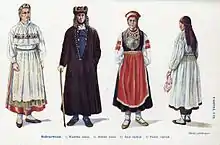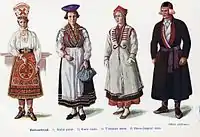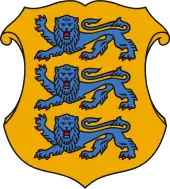Estonians
Estonians (Estonian: eestlased) are a Finnic ethnic group native to Estonia who speak the Estonian language and share a common culture and history.
| Total population | |
|---|---|
| c. 1.3 million | |
| Regions with significant populations | |
| 49,590–100,000[lower-alpha 1][2][3] | |
| 27,113[4] | |
| 25,509[5] | |
| 24,000[6] | |
| 17,875[7] | |
| 10,000-15,000[8] | |
| 7,543[9] | |
| 6,286[10] | |
| 5,092[11] | |
| 2,868[12] | |
| 2,560[13] | |
| 2,000[14] | |
| 1,676[15] | |
| 1,606[16] | |
| 1,482[17] | |
| 686[18] | |
| 228[19] | |
| 111[20] | |
| Languages | |
| Primarily Estonian also Võro and Seto | |
| Religion | |
| Majority irreligious Historically Protestant Christian (Lutheranism)[21][22] Currently Lutheran and regional Eastern Orthodox (Estonian Apostolic Orthodox) minority | |
| Related ethnic groups | |
| other Baltic Finns | |
History
Prehistoric roots
Estonia was first inhabited about 10,000 years ago, just after the Baltic ice lake had retreated from Estonia. Living in the same area for more than 5,000 years would put the ancestors of Estonians among the oldest permanent inhabitants in Europe.[23] On the other hand, some recent linguistic estimations suggest that Finno-Ugrian language arrived around the Baltic Sea considerably later, perhaps during the Early Bronze Age (ca. 1800 BCE).[24][25][26]
The oldest known endonym of the Estonians is maarahvas,[27] literally meaning "land people" or "country folk". It was used up until the mid-19th century, when it was gradually replaced by Eesti rahvas "Estonian people" during the Estonian national awakening.[28][29] Eesti, the modern endonym of Estonia, is thought to be derived from the word Aestii, the name given by the ancient Germanic people to the Baltic people living northeast of the Vistula River. The Roman historian Tacitus in 98 AD was the first to mention the "Aestii" people, and early Scandinavians called the land south of the Gulf of Finland "Eistland" (Eistland is also the current word in Icelandic for Estonia), and the people "eistr". Proto-Estonians (as well as other speakers of the Finnish language group) were also called Chuds (чудь) in Old East Slavic chronicles.
The Estonian language belongs to the Finnic branch of the Uralic family of languages, as does the Finnish language. The branch is a little more than 1000 years old.[30] The first known book in Estonian was printed in 1525, while the oldest known examples of written Estonian originate in 13th-century chronicles.
National consciousness


Although Estonian national consciousness spread in the course of the 19th century during the Estonian national awakening,[31] some degree of ethnic awareness preceded this development.[32] By the 18th century the self-denomination eestlane spread among Estonians along with the older maarahvas.[27] Anton thor Helle's translation of the Bible into Estonian appeared in 1739, and the number of books and brochures published in Estonian increased from 18 in the 1750s to 54 in the 1790s. By the end of the century more than a half of adult peasants could read. The first university-educated intellectuals identifying themselves as Estonians, including Friedrich Robert Faehlmann (1798–1850), Kristjan Jaak Peterson (1801–1822) and Friedrich Reinhold Kreutzwald (1803–1882), appeared in the 1820s. The ruling elites had remained predominantly German in language and culture since the conquest of the early 13th century. Garlieb Merkel (1769–1850), a Baltic-German Estophile, became the first author to treat the Estonians as a nationality equal to others; he became a source of inspiration for the Estonian national movement, modelled on Baltic German cultural world before the middle of the 19th century. However, in the middle of the century, the Estonians became more ambitious and started leaning toward the Finns as a successful model of national movement and, to some extent, toward the neighbouring Latvian national movement. By the end of 1860 the Estonians became unwilling to reconcile with German cultural and political hegemony. Before the attempts at Russification in the 1880s, their view of Imperial Russia remained positive.[32]
Estonians have strong ties to the Nordic countries stemming from important cultural and religious influences gained over centuries during Scandinavian and German rule and settlement.[33] Indeed, Estonians consider themselves Nordic rather than Baltic,[34][35] in particular because of close ethnic and linguistic affinities with the Finns.
After the Treaty of Tartu (1920) recognised Estonia's 1918 independence from Russia, ethnic Estonians residing in Russia gained the option of opting for Estonian citizenship (those who opted were called optandid - 'optants') and returning to their fatherland. An estimated 40,000 Estonians lived in Russia in 1920. In sum, 37,578 people moved from Soviet Russia to Estonia (1920–1923).[36]
Emigration
During World War II, when Estonia was invaded by the Soviet Army in 1944, large numbers of Estonians fled their homeland on ships or smaller boats over the Baltic Sea. Many refugees who survived the risky sea voyage to Sweden or Germany later moved from there to Canada, the United Kingdom, the United States or Australia.[37] Some of these refugees and their descendants returned to Estonia after the nation regained its independence in 1991.
Over the years of independence, increasing numbers of Estonians have chosen to work abroad, primarily in Finland, but also in other European countries (mostly in the UK, Benelux, Sweden, and Germany), making Estonia the country with the highest emigration rate in Europe.[38] This is at least partly due to the easy access to oscillating migration to Finland.
Recognising the problems arising from both low birth rate and high emigration, the country has launched various measures to both increase the birth rate and to lure migrant Estonians back to Estonia. Former president Toomas Hendrik Ilves has lent his support to the campaign Talendid koju! ("Bringing talents home!")[39] which aims to coordinate and promote the return of Estonians who have particular skills needed in Estonia.
Estonians in Canada
One of the largest permanent Estonian community outside Estonia is in Canada with about 24,000 people[6] (according to some sources up to 50,000 people).[40] In the late 1940s and early 1950s, about 17,000 arrived in Canada, initially to Montreal.[41] Toronto is currently the city with the largest population of Estonians outside of Estonia. The first Estonian World Festival was held in Toronto in 1972. Some notable Estonian Canadians include Endel Tulving, Elmar Tampõld, Alison Pill, Uno Prii, Kalle Lasn, and Andreas Vaikla.
See also
Notes
- Statistics Finland does not record ethnicity and instead categorizes the population by their native language; in 2017, Estonian was spoken as a mother tongue by 49,590 people, not all of whom may be ethnic Estonians.[2]
References
- "Population by ethnic nationality". Statistics Estonia. June 2020. Retrieved 6 June 2019.
- "Population". Statistics Finland. 4 April 2018. Retrieved 6 June 2018.
- "Up to 100 000 Estonians work in Finland". Baltic News Network. 27 December 2010. Retrieved 4 October 2018.
- "Total ancestry categories tallied for people with one or more ancestry categories reported 2013 American Community Survey 1-Year Estimates". United States Census Bureau. Archived from the original on 12 February 2020. Retrieved 2 September 2014.
- "Eestlased Rootsis". Archived from the original on 17 February 2015. Retrieved 7 June 2015.
- "Canada-Estonia Relations". Archived from the original on 20 November 2013. Retrieved 17 March 2015.
- Об итогах Всероссийской переписи населения 2010 года [On the results of the All-Russian census in 2010] (in Russian). Russian Federal State Statistics Service. Archived from the original (PPT) on 18 January 2012. Retrieved 17 March 2015.
- "United Kingdom". Ethnologue. Retrieved 12 May 2016.
- "2054.0 Australian Census Analytic Program: Australians' Ancestries (2001 (Corrigendum))" (PDF). Australian Bureau of Statistics. 2001. Retrieved 17 September 2011.
- "Pressemitteilungen - Ausländische Bevölkerung - Statistisches Bundesamt (Destatis)". www.destatis.de.
- "Immigrants and Norwegian-born to immigrant parents, 1 January 2016". Statistics Norway. Accessed 01 May 2016.
- "The distribution of the population by nationality and mother tongue". State Statistics Committee of Ukraine. 2001. Archived from the original on 5 December 2008.
- "Persons usually resident and present in the State on Census Night, classified by place of birth and age group". Central Statistics Office Ireland. Archived from the original on 6 August 2011.
- "Estemb in Belgium and Luxembourg". Retrieved 17 March 2015.
- "Usually resident population by ethnicity at the beginning of the year - 2018". csb.gov.lv.
- "Statistikbanken". www.statistikbanken.dk.
- Official CBS website containing all Dutch demographic statistics. Cbs.nl. Retrieved on 4 July 2017.
- "Présentation de l'Estonie". France Diplomatie. Retrieved 17 April 2018.
- https://sefstat.sef.pt/forms/distritos.aspx. Missing or empty
|title=(help) - "Dialog". rannsokn.hagstofa.is.
- Ivković, Sanja Kutnjak; Haberfeld, M.R. (10 June 2015). Measuring Police Integrity Across the World: Studies from Established Democracies and Countries in Transition. Springer. p. 131. ISBN 9781493922796.
Estonia is considered Protestant when classified by its historically predominant major religion (Norris and Inglehart 2011) and thus some authors (e.g., Davie 2003) claim Estonia belongs to Western (Lutheran) Europe, while others (e.g., Norris and Inglehart 2011) see Estonia as a Protestant ex-Communist society.
-
Ringvee, Ringo (16 September 2011). "Is Estonia really the least religious country in the world?". The Guardian.
For this situation there are several reasons, starting from the distant past (the close connection of the churches with the Swedish or German ruling classes) up to the Soviet-period atheist policy when the chain of religious traditions was broken in most families. In Estonia, religion has never played an important role on the political or ideological battlefield. The institutional religious life was dominated by foreigners until the early 20th century. The tendencies that prevailed in the late 1930s for closer relations between the state and Lutheran church [...] ended with the Soviet occupation in 1940.
Missing or empty|url=(help) - Unrepresented Nations and peoples organization By Mary Kate Simmons; p141 ISBN 978-90-411-0223-2
- Petri Kallio 2006: Suomalais-ugrilaisen kantakielen absoluuttisesta kronologiasta. — Virittäjä 2006. (With English summary).
- Häkkinen, Jaakko (2009). "Kantauralin ajoitus ja paikannus: perustelut puntarissa. – Suomalais-Ugrilaisen Seuran Aikakauskirja" (PDF). p. 92.
- https://web.archive.org/web/20190512050452/https://www.cell.com/current-biology/fulltext/S0960-9822(19)30424-5
- Ariste, Paul (1956). "Maakeel ja eesti keel. Eesti NSV Teaduste Akadeemia Toimetised 5: 117–24; Beyer, Jürgen (2007). Ist maarahvas ('Landvolk'), die alte Selbstbezeichnung der Esten, eine Lehnübersetzung? Eine Studie zur Begriffsgeschichte des Ostseeraums". Zeitschrift für Ostmitteleuropa-Forschung. 56: 566–593.
- Beyer, Jürgen (2011). "Are Folklorists Studying the Tales of the Folk?" (PDF). Folklore. Taylor & Francis. 122 (1): 12–13. doi:10.1080/0015587X.2011.537132. S2CID 144633422. Retrieved 21 January 2020.
- Paatsi, Vello (2012). ""Terre, armas eesti rahwas!": Kuidas maarahvast ja maakeelest sai eesti rahvas, eestlased ja eesti keel". Akadeemia (in Estonian). 24 (2): 20–21. ISSN 0235-7771. Retrieved 21 January 2020.
- https://web.archive.org/web/20190513003802/https://www.phil.muni.cz/jazyk/files/uralic-migrations.pdf
- Gellner, Ernest (1996). "Do nations have navels?". Nations and Nationalism. 2 (3): 365–70. doi:10.1111/j.1469-8219.1996.tb00003.x.
- Raun, Toivo U (2003). "Nineteenth- and early twentieth-century Estonian nationalism revisited". Nations and Nationalism. 9 (1): 129–147. doi:10.1111/1469-8219.00078.
- Piirimäe, Helmut. Historical heritage: the relations between Estonia and her Nordic neighbors. In M. Lauristin et al. (eds.), Return to the Western world: Cultural and political perspectives on the Estonian post-communist transition. Tartu: Tartu University Press, 1997.
- Estonian foreign ministry report Archived 25 March 2009 at the Wayback Machine, 2004
- Estonian foreign ministry report Archived 7 March 2008 at the Wayback Machine, 2002
- Лоткин И.В. Оптационная кампания и эвакуация граждан прибалтийских государств на историческую родину в начале 1920-х годов (PDF). library.krasu.ru (in Russian). Archived from the original (PDF) on 10 October 2006.
- Past, Evald, By Land and By Sea, Booklocker, 2015, ISBN 978-0-9867510-0-4
- "The CIA World Factbook Country Comparison of net migration rate". cia.gov.
- "Toome talendid Eestimaale tagasi - Talendid Koju!". talendidkoju.ee. Archived from the original on 20 December 2017. Retrieved 8 November 2011.
- "Estonian Embassy in Ottawa". Retrieved 17 March 2015.
- "The Estonian Presence in Toronto". Archived from the original on 12 March 2012. Retrieved 17 March 2015.
Further reading
- Petersoo, Pille (January 2007). "Reconsidering otherness: constructing Estonian identity". Nations and Nationalism. 13 (1): 117–133. doi:10.1111/j.1469-8129.2007.00276.x.
External links
| Wikimedia Commons has media related to People of Estonia. |
| Wikiquote has quotations related to: Estonians |
- Office of the Minister for Population and Ethnic Affairs: Estonians abroad
- From Estonia to Thirlmere (online exhibition)
- Our New Home Meie Uus Kodu: Estonian-Australian Stories (online exhibition)

